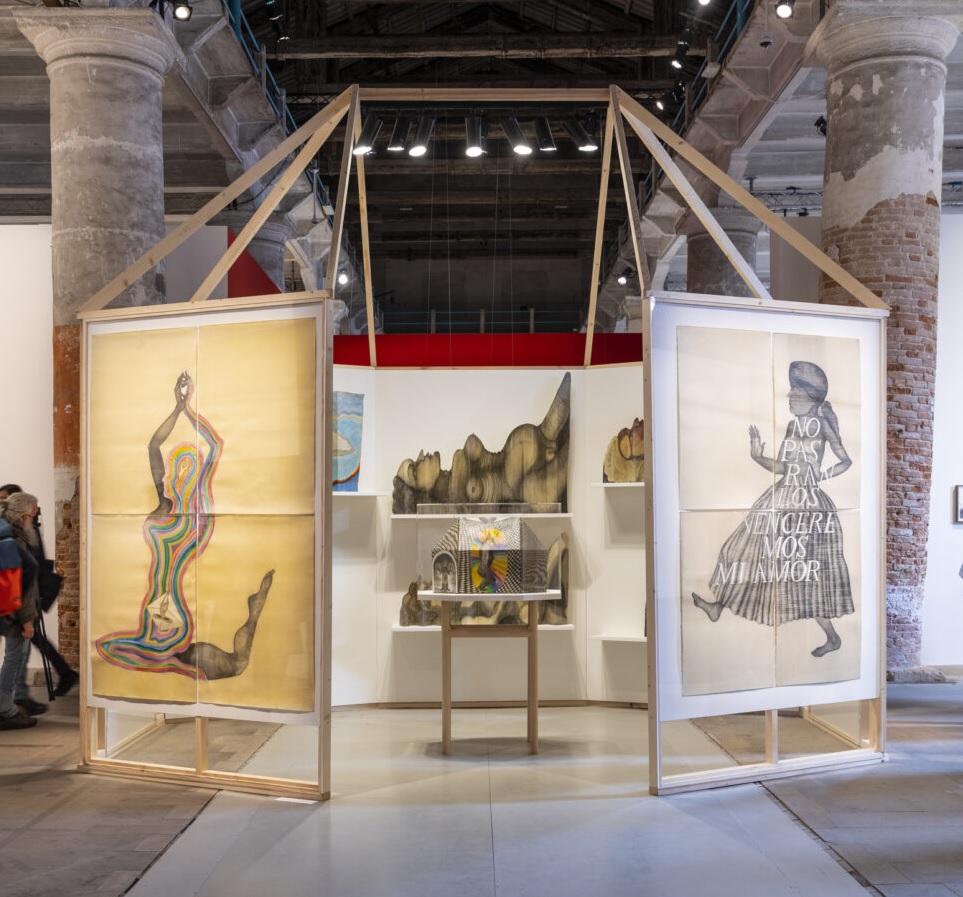To each person a mountain range
Sandra Vásquez de La Horra
[02 de janeiro de 2023]

Between April and November 2022, the public attending the Venice Biennale could see a significant body of work by Sandra Vásquez de la Horra. Along the route of the Arsenale, the artist presented her installation entitled Las cordilleras encuentradas (The Found Mountain Ranges, 2017–2021). In the center of a room, the artist proposed an architecture similar to the schematic structure of a house. The domestic format of the installation drew attention and invited the public’s body—overstimulated by the typical biennial excesses—to enter its space and calmly wander with their eyes over the different images that make up the whole.
In this installation by Sandra, the equation between the parts and the whole draws special attention. Large-scale drawings of different components were shown on walls that suggested the outside of a house. Each image was divided into four fragments and featured a female body that pointed to a narrative. On the right side of the entrance, one of these bodies bore the Spanish phrase “No pasarán los venceremos mi amor”—in english, they won’t get through we’ll beat them my love. Conversely, a silhouette strikes a pose reminiscent of dance and/or meditation against a field of rainbow colors. Around the circumference of the installation, we see other images that refer to light, motherhood, landscape, and the passage of time. It is interesting to note how these images composed of different parts give the installation the appearance of a jigsaw puzzle, of reconnection between elements, and naturally take us back to the museum, the archive, and the activity of memory.

Once our body enters the installation—and, therefore, its home, its intimacy and, perhaps, its organism—we find ourselves facing what could be the remembrance of a geology museum; against the wall, we see the contours of women that resemble the structural cut of a mountain. As the artist said in different interviews, her work suggests an understanding of the world not based on the binarism between humans and nature but rather approaches a phenomenological perspective on the whole. No mountain range is the same as the other; it’s not just about bodies with different faces but also with weights, volumes, limbs, and fats that differ from each other.
Looking at the shapes of these mountain ranges—works made of folded paper covered with wax—it seems inevitable to associate them with music. What sounds would these mountain ranges make? What are the cadences of each of these bodies? Or, thinking the other way around, what are the geological layers of each accordion instrument? Continuing with the artist’s interest in bringing the universe of drawing to the making of objects and sculpture, we have a miniature house at the center of the installation. A body surrounded by an ellipse of colors is at the center of the object and contrasts with the checkered and black-and-white patterns of the object’s architecture. The circularity and curvature of this female body seem to oppose the architecture’s symmetrical and rationalist character. This object reinforces reflection on the constant domesticity of Sandra’s work; here is the house within the house, like a doll’s house. Given that her research centers on the human body, drawing, and installation, it is unsurprising that scenery, simulacrum, and the theater of life frequently appear in her works.

Returning to the way the artist titled this installation, we notice that the title also entails a question: which mountain ranges is she referring to? Perhaps there is an obvious way to read the work in terms of the artist being born in Chile and seen as a “Latin American artist,” but is it fair to say that this is the only direction the installation suggests? Since the work is in Venice, wouldn’t it also make sense to think about the Alps? Or, depending on each of the 800,000 Biennial visitors, could we not broaden the interpretation of the work to the point where each spectator could find—as the title says—a different mountain range?

The open interpretations facilitated by Sandra’s images are one of the aspects of her research that caught my attention most. Even though some of her titles point to a specific identity—for example, when she chooses to call one of her works “Pacha-Mama”—when we go through her career, we see languages, words, and iconographies that point in the most diverse directions. The Andes, the Alps, and Fuji are found in her geological fiction, just as her gaze was attentive both to what she could observe in the museums she visited in Germany and to what she could learn daily from her experiences with Afro-Caribbean religions.
From mountain to mountain, body to body, visitor to visitor, we are invited to be surprised by an artist who suggests, as one of her works says, that “behind a cloud, there is a UFO.” There is always something that seems to shelter but also astonishes us in Sandra Vásquez de la Horra’s research. May we take a slow and endless walk through the meanders of her mountain ranges.
(texto feito para a publicação relativa à exposição “Das archetypische ich”, na Gutshaus Steglitz, em Berlim, em março de 2023)